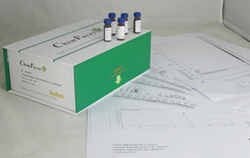Hot Products



| Catalog No. | Information |
| CFN92105 | Wilfortrine Wilfortrine can induce liver cancer cell HepG2 apoptosis, but with no effect on the cell cycle, mainly by promoting Bax expression and inhibiting anti-apoptotic protein Bcl-2 expression. The combined treatment using wilfortrine and paclitaxel can inhibit proliferation and invasion of liver cancer cells via down-regulating Bcl-2 and up-regulating Bax, with better efficacy than single use of either drug. Wilfortrine and euonine (40.80 mg/(kg.d) x 4d ip) show marked depressant effects on humoral mediated immunity using the hemolysin reaction as indices. |
| CFN98624 | Wilsonine Standard reference |
| CFN91895 | Withaferin A Withaferin A(WFA) has anti-inflammatory, anti-oxidant, immune modulatory, cardioactive, antithrombotic and central nervous system effects, it could act as an anti-fibrotic compound against fibroproliferative diseases, including, but not limited to, cardiac interstitial fibrosis. WFA is a proteasomal inhibitor promotes healing after injury and exerts anabolic effect on osteoporotic bone. WFA is a potent breast cancer anti-metastatic agent and the anti-metastatic activity of WFA is, at least in part, mediated through its effects on vimentin and vimentin ser56 phosphorylation; it induces p53-dependent apoptosis by repression of HPV oncogenes and upregulation of tumor suppressor proteins in human cervical cancer cells, it can be exploited as a potent therapeutic agent for the treatment and prevention of cervical cancer without deleterious effects. |
| CFN91964 | Withanolide A Withanolide A extends the lifespan in human EGFR-driven cancerous Caenorhabditis elegans. Withanolide A may serve as potential neuroprotective agent due to inhibition of MAPK family proteins and activation of PI3K/Akt signaling, it plays an important role in central muscarinic receptor functional balance and activation of antioxidant system in the cerebral cortex of temporal lobe epileptic condition. Withanolide A shows anticancer activity against the SK-Br-3 cells. |
| CFN91963 | Withanolide B Reference standards. |
| CFN96435 | Withanolide C Withanolide C is a natural product from Physali alkekengi. |
| CFN70327 | Withanone Withanone can affords protection against NMDA-induced excitotoxicity in neuron-like cells, it may serve as potential neuroprotective agent, it shows promise in Alzheimer's disease treatment because of cognitive benefits. Withanone as a potential candidate molecule in cancer therapy. |
| CFN70350 | Withanoside IV Withanoside IV improves hindlimb function by facilitating axonal growth and increase in peripheral nervous system myelin level after spinal cord injury. Withanoside IV may prevent or decrease the growth of tumors in human. Withanoside IV showed significant neurite outgrowth activity at a concentration of 1 μM on a human neuroblastoma SH-SY5Y cell line. Withanoside IV (10 micromol/kg/day) significantly improved memory deficits in Abeta(25-35)-injected (25 nmol, i.c.v.) mice and prevented loss of axons, dendrites, and synapses. |
| CFN70323 | Withanoside V Reference standards. |
| CFN97089 | Wogonin Wogonin is an inhibitor of CDK9, which has anti-inflammatory and anti-tumor activities, it could be developed into an efficient natural sensitizer for resistant human myelogenous leukemia. It has a wide spectrum of targets including PGE2, NO, Nrf2, Src, MEK1/2, ERK1/2, NFκB,MLCK, MLC. |